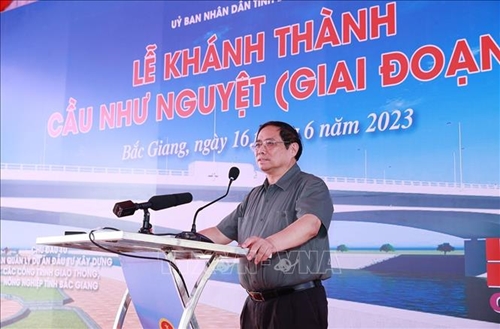Construction of the bridge started in April 2022 at a total cost of over 456 billion VND (19.8 million USD) sourced from the provincial budget. The bridge has a total length of about 445m and a width of 16m, with two approach road sections stretching 800m. It lies on Hanoi - Bac Giang expressway, crossing the Cau river.
    |
 |
|
At the inauguration ceremony of Nhu Nguyet bridge 2 |
Speaking at the inauguration ceremony, the Prime Minister said the bridge will help promote socio-economic development in the Northeastern region in general and Bac Giang in particular, as it serves as a gateway to the province.
He expressed his hope that after the bridge was inaugurated, people will travel more conveniently, contributing to realising the Politburo’s resolution on the development of the Red River Delta.
In the afternoon of the same day, the Prime Minister attended the groundbreaking ceremony for a second-phase social housing project for workers in Nenh townlet in Viet Yen district of Bac Giang province.
The project, covering a total area of up to 12.6ha, consists of 16 20-storey apartment buildings and is estimated to cost nearly 5 trillion VND (212.5 million USD). It is expected to provide round 7,000 apartments for over 20,000 workers in the province.
In the first stage, 2,500 apartments will be delivered by the end of March 2024. Meanwhile in the second stage, more than 1,500 apartments will be built and handed over in the fourth quarter of 2024.
Speaking at the groundbreaking ceremony, Prime Minister Pham Minh Chinh asked Bac Giang and localities to continue allocating resources and land for social housing development projects.
Financial institutions, particularly the Vietnam Bank for Social Policies must create favourable conditions for low-income individuals and workers in industrial zones to access capital and purchase or rent social housing.
On the occasion, he called on departments, localities and businesses to join hands and fulfill the goal of building at least 1 million social housing units for low-income individuals and workers in industrial zones by 2030.
Source: VNA